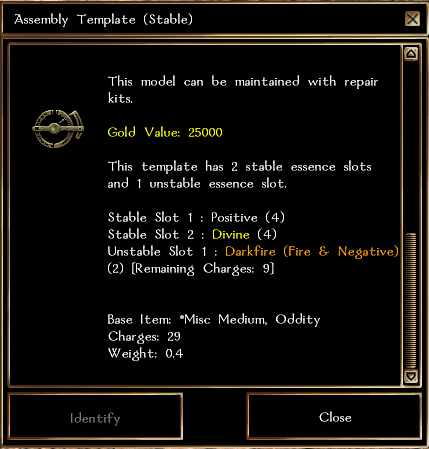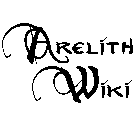Assembly Template

Assembly templates are separate items which store essences and imbued spells. These templates can be used to enchant ammunition. Assembly Templates are one of the most complex crafts in Arelith. Construction of a Template can take several different Trade Skills, uses special ammunition bundles, and requires a caster (or consumable) to charge the Template for use with the bundles. In the end, all the work is worth it for the very powerful ammunition that Templates produce.
Quick Start
General Steps on how to utilize the Templates:
- Get a bundle via Crafting or the Custom Craft Ammunition Feat automatically gained with a Missile/Thrown Weapon Group Focus.
- If crafting, you'll need either smithing (bullets, arrows, bolts, darts, shuriken & throwing axe), carpentry (arrows & bolts), or art craft (bullets) for the bundles.
- If using the Craft Ammunition Feat, equip missile/throwing weapon and have the relevant feat (weapon focus: missile or thrown) first, then use the "Create Ammunition" abilityand get a bundle relative to your character level.
- Acquire an Assembly Template
- It requires at least three different crafting skills for semi-decent ones: Art, Smithing, and Carpentry
- Apply permanent essences (from Alchemy) on the template to available stable slots in the Template by using the essence on the Template
- Apply temporary essences (from Alchemy) and/or any Arcane/Divine weapon magics to available unstable slots in the Template by using or casting the essence or spell on the Template
- Equip the Bundle (it will be a "club") and use the targeting special ability (Southeast "3" on right-click menu) on the Template in your inventory > you get 100 awesome ammo, each bundle has 500 ammunition worth
- Using the -quiverall command will craft 500 ammo instead of 100.
Using the bundle on the Template will reduce the charge of any unstable slots filled with spells or temporary essences. Using the bundle will also reduce the durability of the template itself shown as a separate charges. Unstable slots can be emptied and refilled with more temporary essences or spells, but reducing durability to 0 will destroy the Template. Some Templates can be repaired and others cannot.
Each bundle has a 'Unique Power: Self-Only' and a 'Unique Power' targeted ability. The first can be used to produce unenchanted ammunition. The second (targeted ability) can be targeted on an assembly template and will produce ammunition enchanted with the properties stored on that template.
Crafting Assembly Templates
Art Crafting, Smithing, and Carpentry all qualify to craft the following templates:
| Templates | Stable | Unstable | Condition | Raw Material | Gems | Ingots | Gears | Herbalism |
|---|---|---|---|---|---|---|---|---|
| Basic (DC5) | 0 | 1 | Permanent | Softwood | Aventurine | Tin | N/A | N/A |
| Simple (DC15) | 1 | 1 | Permanent | Hardwood | Amethyst | Tin | Brass | N/A |
| Standard (DC25) | 0 | 3 | Consumable | 2 Hardwood | Fire Agate | Silver | 2 Brass | N/A |
| Stable (DC35) | 2 | 1 | Repairable | 2 Hardwood | Garnet | N/A | 2 Brass | Small Seed Balm |
- Only Smithing and Carpentry can repair the repairable Templates with Craft Points in the crafting station.
- Only Smithing and Carpentry repair kits can repair Templates.
- Stable slots are for permanent essences only.
- Unstable slots are for temporary essences and/or any arcane/divine magics that affect weapons.
- The Standard Template is not repairable.
Note: Newly created repairable templates comes with more charges than they can hold. They must 20 or lesser charges to be able to repair them.
Components
Trade Skill requirements and materials for crafting components for Assembly Templates:
| Trade Skill | Components | Materials | |||
|---|---|---|---|---|---|
| Forging (11) | Brass Gears (DC10) | Flask of Oil | Brass Ingot | ||
| Tin Ingot (DC5) | 2 Tin Chunk | 4 Coal | |||
| Brass Ingot (DC6) | Copper chunk | Zinc chunk | 2 Coal | ||
| Silver Ingot (DC 13) | 2 Silver Chunk | 4 Coal | |||
| Herbalism (13) | Flask of Oil (DC15) | 2 Harnak Seeds | Glass Vial | ||
| Small Seed Balm (DC10) | 3 Strideleaf | 6 Nuts | 3 Sassone Leaves | 6 Yarrow Leaves | |
| Art Crafting (7) | Glass Vial (DC3) | 2 Glass | 2 Coal | ||
| Glass (DC1) | 2 Sand | 2 Coal | |||
| Aventurine (DC3) | 1 Raw Gem (Aventurine) | ||||
| Amethyst (DC5) | 1 Raw Gem (Amethyst) | ||||
| Fire Agate (DC2) | 1 Raw Gem (Fire Agate) | ||||
| Garnet (DC9) | 1 Raw Gem (Garnet) | ||||
Assembly Template Slots
The two types of slots are Stable and Unstable. Stable slots take permanent essences (from Alchemy) and unstable slots take temporary essences (from Alchemy) or weapon magics.
For all slots, consider the types of essences and magics that are being applied:
- Templates with a certain elemental damage types will conflict with spells that attempt to add the same.
- If the template has a Stable Slot with sonic damage from a permanent sonic essence, the unstable slot can't take Deafening Clang.
- If the template has a Stable Slot with fire damage from a 4 damage permanent fire essence, the unstable slot will take Darkfire because the effects are technically different, but the elements will not stack. Fire damage from the ammunition would be 4 from the permanent essence and the 1d6 fire from Darkfire would be discarded, even on crits. The 1d6 negative damage would still apply since there is no conflict.
- Players are advised to apply slots (temporary or permanent) with elements that are not listed in weapon magics so you do not have any overlapping. Overlapping elements will choose the highest and discard all the rest.
- The exception being Holy Sword and Bless Weapon's Divine damage since they are specific, but damage from a Divine Essence will not stack vs Evil, Undead, Outsider, or Dragon. The essence damage will apply if the specific types aren't present.
Stable Slots
Stable slots are straightforward application of permanent essences (from Alchemy). Using the permanent essence on the template will fill the slot with the 1d4, 4, or 1d6 damage type of the essence. Choose the permanent essence carefully because they are often expensive and cannot be changed once applied. When choosing permanent essences for Stable slots consider what damage types are best suited for any unstable slots on the Template as well. Stable slots do not have charges and are never used up.
Unstable Slots
Unstable slots in Assembly Templates can take temporary essences (from Alchemy) or weapon magics. These slots have charges that are used up with each bundle use applied to the Template until the charges are exhausted from the Template. Temporary essence effects are straightforward applications of the essences. The essence's 1d4 or 1d6 damage type applies the unstable slot. Weapon magics are a little more complicated:
- For weapon magics CL stands for overall Character Level, not Caster Level.
- Level 27 Wizard / 3 Ranger would apply spells cast from the spellbook to a template at level 30 even though their caster level is 27.
- Level 20 Fighter / 7 Weapon Master / 3 Rogue would apply consumables (wands/scrolls) spells to a template at level 30 even though their caster level is 0.
- Level 2 Swashbuckler using a consumable Elemental Weapon scroll (the scroll itself being caster level 17) would cast at that level and get a 1d6 elemental damage in the Unstable slot.
- Caster level from consumables, if higher, will apply to higher progression for Assembly Templates, but not for consumables cast on melee weapons.
- Mechanically, adding piercing damage to an arrow would cause the game to choose the highest and discard the other. Physical damage is applied so that similar types do not overlap and they are additive. The physical weapon magic types (Magic Weapon, Greater Magic Weapon and Keen Edge) cannot be combined.
- Slashing (throwing axe) > physical adds Piercing.
- Piercing (arrow, bolt, dart, shuriken) > physical adds Slashing.
- Bludgening (bullet) > physical adds Piercing.
| Spell | Character Level 30 Effect | Spellbook | Consumable | Progression |
|---|---|---|---|---|
| Blackstaff | 3 Magical damage | Wizard, Sorcerer | Scroll |
CL 1: 1 |
| Magic Weapon | 3 Physical damage | Bard, Cleric, Paladin, Sorcerer, Wizard, Favored Soul |
Wand, Scroll |
CL 1: 1 |
| Greater Magic Weapon | 5 Physical damage | Bard, Cleric, Paladin, Sorcerer, Wizard, Favored Soul |
Wand, Scroll |
CL 1: 1 |
| Deafening Clang | 5 Sonic damage | Paladin | Wand, Scroll |
CL 1: 1 |
| Darkfire | 3 Fire and 3 Negative damage |
Cleric, Favored Soul, Harbinger | Wand, Scroll |
CL 1: 1 & 1 |
| Elemental Weapon | 1d8 Elemental damage (type dependent on -stream) |
Wizard, Sorcerer | Wand, Scroll |
CL 1: 1d4 |
| Bless Weapon | 2d4 Divine damage vs Undead, Outsiders, and Dragons |
Paladin | Wand, Scroll |
CL 1: 2d4 vs Undead |
| Holy Sword | 1d8 Divine vs Evil | Paladin | N/A |
CL 1: 1d8 |
| Keen Edge | 1d6 Physical damage and DC 26 Wounding |
Bard, Wizard, Sorcerer | Wand, Scroll |
CL 1: 2 & 16 DC |
| Blade Thirst | 1d6 Negative damage and Vampiric +3 |
Ranger | Wand, Scroll |
CL 1: 2 & 2 |
| Inflict Serious Wounds | 1d6 Negative damage | Blackguard | N/A |
CL 1: 1d4 |
| Inflict Critical Wounds | 1d8 Negative damage | Blackguard | N/A |
CL 1: 1d4 |
